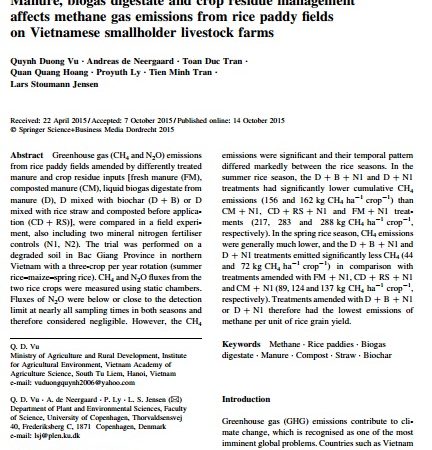

Greenhouse gas (CH4 and N2O) emissions from rice paddy fields amended by differently treated manure and crop residue inputs [fresh manure (FM), composted manure (CM), liquid biogas digestate from manure (D), D mixed with biochar (D ? B) or D mixed with rice straw and composted before application (CD ? RS)], were compared in a field experiment, also including two mineral nitrogen fertiliser controls (N1, N2). The trial was performed on a degraded soil in Bac Giang Province in northern Vietnam with a three-crop per year rotation (summer rice–maize–spring rice). CH4 and N2O fluxes from the two rice crops were measured using static chambers. Fluxes of N2O were below or close to the detection limit at nearly all sampling times in both seasons and therefore considered negligible. However, the CH4 emissions were significant and their temporal pattern differed markedly between the rice seasons. In the summer rice season, the D ? B ? N1 and D ? N1 treatments had significantly lower cumulative CH4 emissions (156 and 162 kg CH4 ha-1 crop-1) than CM ? N1, CD ? RS ? N1 and FM ? N1 treatments (217, 283 and 288 kg CH4 ha-1 crop-1, respectively). In the spring rice season, CH4 emissions were generally much lower, and the D ? B ? N1 and D ? N1 treatments emitted significantly less CH4 (44 and 72 kg CH4 ha-1 crop-1) in comparison with treatments amended with FM ? N1, CD ? RS ? N1 and CM ? N1 (89, 124 and 137 kg CH4 ha-1 crop-1, respectively). Treatments amended with D ? B ? N1 or D ? N1 therefore had the lowest emissions of methane per unit of rice grain yield.








